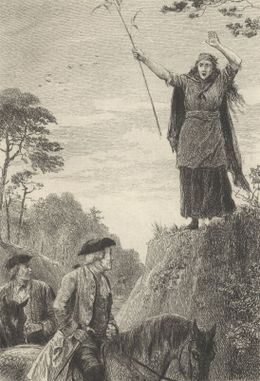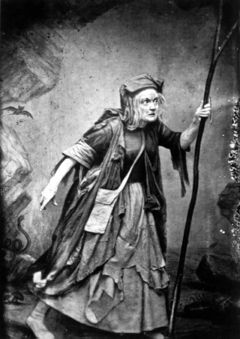Annotation:Meg Merrilies: Difference between revisions
(Created page with "=='''Back to [[{{BASEPAGENAME}}]]'''== ---- <p><font face="garamond, serif" size="4"> '''MEG MERRILIES/MERRILEES'.''' English, Scottish, Shetland; Country Dance Tune, Hornpipe...") |
No edit summary |
||
| (13 intermediate revisions by 2 users not shown) | |||
| Line 1: | Line 1: | ||
{{TuneAnnotation | |||
|f_annotation='''MEG MERRILIES/MERRILEES'.''' English, Scottish, Shetland; Country Dance Tune, Hornpipe or Reel. G Major (Dixon, Hardings): A Major (Athole, Honeyman, Howe, Hunter, Kerr, Lees, Lowe). Standard tuning (fiddle). AB (Athole): AAB (Kerr): AABB (Honeyman, Howe, Hunter, Lees): AABB' (Hardings): ABC (Lowe): AABBCCDDEEAABB (Dixon). Meg Merrilies is the name of a Scottish country dance, commonly taught by dancing masters in the 19th century. Elias Howe (c. 1867), however, classifies it as an "English Country Dance." The Shetland variant has a distinct character that distinguishes it from the Scottish (Cooke). Dixon (1995) prints the melody with variation sets by Robert Whinham (1814-1893), a musician, teacher, composer, dancing master and fiddler originally from Morpeth, Northumberland. | |||
<br /> | |||
'''MEG MERRILIES/MERRILEES'.''' English, Scottish, Shetland; Country Dance Tune, Hornpipe or Reel. G Major (Dixon, Hardings): A Major (Athole, Honeyman, Howe, Hunter, Kerr). Standard tuning (fiddle). AB (Athole): AAB (Kerr): AABB (Honeyman, Howe, Hunter): AABB' (Hardings): AABBCCDDEEAABB (Dixon). Meg Merrilies is the name of a Scottish country dance, commonly taught by dancing masters in the 19th century. Elias Howe (c. 1867), however, classifies it as an "English Country Dance." The Shetland variant has a distinct character that distinguishes it from the Scottish (Cooke). Dixon (1995) prints the melody with variation sets by Robert Whinham (1814-1893), a musician, teacher, composer, dancing master and fiddler originally from Morpeth, Northumberland. | <br /> | ||
<br> | However, the title Meg Merrilies derives from the name of a character in Sir Walter Scott's '''Guy Mannering''' [http://en.wikipedia.org/wiki/Guy_Mannering] and, separately, the subject of a poem by John Keats (1795–1821) that begins: | ||
<br> | [[File:meg2.jpg|260px|thumb|left|The Cure of Meg Merrilees--Drawn and Etched by C. O. Murray]]: | ||
Meg Merrilies | ''Old Meg she was a Gipsy,''<br /> | ||
''And liv'd upon the Moors:''<br /> | |||
''Her bed it was the brown heath turf,''<br /> | |||
''And her house was out of doors.''<br /> | |||
<br /> | |||
''Her apples were swart blackberries,''<br /> | |||
''Her currants pods o' broom;''<br /> | |||
''Her wine was dew of the wild white rose,''<br /> | |||
''Her book a churchyard tomb.'' <br /> | |||
[[File:meg.jpg|240px|thumb|right|Charlotte Cushman as Meg Merrilies in "Guy Mannering."]] | |||
The characters in both works were based on a person named Jean Gordon, a mid-18th century inhabitant of the village of Kirk Yetholm in the Cheviot Hills, and wife of the King of the Gypsies, Patrick (sometimes "Johnnie") Faa. The character is that of a gypsy, or a half-mad seeress. '''Guy Mannering''' was adapted for the stage and the character of Meg was memorably played by the American actress Charlotte Cushman (1816-1876) in New York. | |||
'' | |f_source_for_notated_version=the manuscript of piper and fiddler Tom Armstrong of Hindley Steele, Northumberland, c. 1850 [Dixon]. | ||
|f_printed_sources=Dixon ('''Remember Me'''), 1995; p. 62. '''Hamilton's Universal Tune Book''', 1844; p. 36. '''Hardings All-Round Collection''', 1905; No. 74, p. 23. Honeyman ('''Strathspey, Reel and Hornpipe Tutor'''), 1898; p. 45 (appears as "Meg Merrilees' Hornpipe"). Howe ('''1000 Jigs and Reels'''), c. 1867; p. 71. Hunter ('''Fiddle Music of Scotland'''), 1988; No. 315. Kerr ('''Merry Melodies, vol. 1'''), c. 1880; No. 1, p. 23. Laybourn ('''Köhler’s Violin Repository vol. 2'''), 1881-1885, p. 156. J. Kenyon Lees ('''Balmoral Reel Book'''), Glasgow, 1910; p. 27. Joseph Lowe ('''Lowe's Collection of Reels, Strathspeys and Jigs, book 3'''), 1844–1845; p. 21. Stewart-Robertson ('''The Athole Collection'''), 1884; p. 142. | |||
|f_recorded_sources=Rounder 1839, Harry Cox - "<span>What Will Become of England" (2000).</span> | |||
|f_tune_annotation_title=https://tunearch.org/wiki/Annotation:Meg_Merrilies > | |||
}} | |||
--------------- | |||
< | |||
------------- | |||
---- | |||
Latest revision as of 04:36, 21 April 2021
X:1 T:Meg Merrilies M:C| L:1/8 R:Country Dance B:Clementi & Co. - Periodical Collection of Popular Dances No. 26 (c. 1820's?, p. 2) Z:AK/Fiddler's Companion K:Bb de|fdBd fbag|(gf).f.f gfde|fdBd fgfd|(dc).c.c dcde| fdBd fbag|(gf).f.f gfde|fgfd fbfd|(cB)BB B2:| |:f2|efgf efcf|dfBf dfBf|efgf efcf|dB TBA/B/ fBbB| efgf efcf|dfBf dfBf|efgf efcf|dBBB B2:|]
MEG MERRILIES/MERRILEES'. English, Scottish, Shetland; Country Dance Tune, Hornpipe or Reel. G Major (Dixon, Hardings): A Major (Athole, Honeyman, Howe, Hunter, Kerr, Lees, Lowe). Standard tuning (fiddle). AB (Athole): AAB (Kerr): AABB (Honeyman, Howe, Hunter, Lees): AABB' (Hardings): ABC (Lowe): AABBCCDDEEAABB (Dixon). Meg Merrilies is the name of a Scottish country dance, commonly taught by dancing masters in the 19th century. Elias Howe (c. 1867), however, classifies it as an "English Country Dance." The Shetland variant has a distinct character that distinguishes it from the Scottish (Cooke). Dixon (1995) prints the melody with variation sets by Robert Whinham (1814-1893), a musician, teacher, composer, dancing master and fiddler originally from Morpeth, Northumberland.
However, the title Meg Merrilies derives from the name of a character in Sir Walter Scott's Guy Mannering [1] and, separately, the subject of a poem by John Keats (1795–1821) that begins:

Old Meg she was a Gipsy,
And liv'd upon the Moors:
Her bed it was the brown heath turf,
And her house was out of doors.
Her apples were swart blackberries,
Her currants pods o' broom;
Her wine was dew of the wild white rose,
Her book a churchyard tomb.

The characters in both works were based on a person named Jean Gordon, a mid-18th century inhabitant of the village of Kirk Yetholm in the Cheviot Hills, and wife of the King of the Gypsies, Patrick (sometimes "Johnnie") Faa. The character is that of a gypsy, or a half-mad seeress. Guy Mannering was adapted for the stage and the character of Meg was memorably played by the American actress Charlotte Cushman (1816-1876) in New York.

